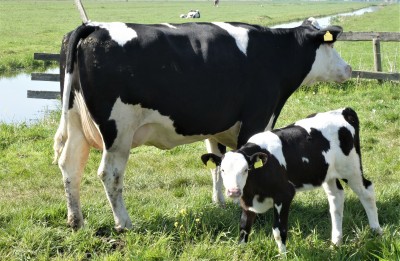Aspirin after calving can provide relief to dairy cows, increase milk production
Alycia Drwencke, Dairy Management Specialist
Southwest New York Dairy, Livestock and Field Crops Program

Aspirin after calving can provide relief to dairy cows, increase milk production by Chuck Gill with DairyBusiness
Dairy cows that received a short course of anti-inflammatory medication after calving had lower metabolic stress and produced more milk than untreated cows, according to researchers, who say the regimen they tested could be adopted more easily by producers than previously studied treatment strategies.
"Dairy cows experience systemic inflammation and stress around calving, and these responses increase the risk of diseases, negatively affecting the cows' health and performance," said lead researcher Dr. Adrian Barragan, clinical assistant professor of veterinary and biomedical sciences in Penn State's College of Agricultural Sciences.
An extension veterinarian, Barragan noted that stress and inflammation related to calving can increase the incidence of diseases such as mastitis, an infection of the udder, and clinical metritis, which is a bacterial infection of the uterus that can affect up to 40% of postpartum animals. Previous research suggests that each case of clinical metritis can cost producers about $359, and the total estimated costs of metritis to the dairy industry are estimated at $650 million.
"Decreasing this inflammation and stress could be a potential strategy for preventing disease in early lactation, improving the welfare and performance of dairy cows, and reducing disease-related costs for producers," he said.
Earlier research had shown that nonsteroidal anti-inflammatory drugs, or NSAIDs, can reduce inflammation and increase milk production in postpartum cows. However, these studies involved numerous time-consuming interventions that require extra labor. In addition, treatment length and intervals, ensuring accurate individual drug dosage, and available methods of administration may make these strategies difficult to mesh with modern dairy farm logistics.
Barragan explained that in this study, the research team set out to test a regimen that would be less labor-intensive and less expensive than similar methods used in previous studies. A major goal of the project was to prove the effectiveness of a treatment that would be relatively easy and economical for producers to adopt.
The researchers, who recently reported their findings in the Journal of Dairy Science, hypothesized that cows treated with the NSAID acetylsalicylic acid — better known as aspirin — after giving birth would have lower incidence of diseases, lower biomarkers of metabolic stress and increased milk yields compared to untreated cows.
To test this, 246 cows at a family-owned dairy farm in central Pennsylvania were studied, from calving throughout lactation. The treatment group received two treatments with aspirin, the first within 12 hours after birthing and the second 24 hours later.
The aspirin was administered in boluses, or in pill form, as opposed to previous studies' protocols in which the drug was pumped into the rumen or injected — methods that are more labor-intensive and time consuming — or mixed in drinking water, which may lead to inexact dosing. Earlier research also called for shorter intervals between treatments and/or longer courses of treatment.
"We found that cows treated with the proposed anti-inflammatory strategy had lower metabolic stress 14 days after calving and a lower incidence of clinical metritis, compared to untreated cows," Barragan said. "Also, treated cows that had given birth more than once, known as multiparous cows, produced 3.6 more pounds of milk per day during the first 60 days in milk compared to their untreated counterparts."
Although the published study did not include an economic analysis, he pointed out that the estimated value of this increased milk production for an average Pennsylvania dairy herd of 80 cows — taking into account current milk prices and costs for aspirin treatment and labor — would be about $2,250 annually.
"These results suggest that an easy-to-apply, economical and practical anti-inflammatory strategy after calving may improve the health of dairy cows, enhancing both animal welfare and farm profitability," Barragan said.
Other Penn State researchers and students contributing to this study were Dr. Ernest Hovingh, extension veterinarian and associate research professor of veterinary and biomedical sciences, Louise Byler, former research assistant in veterinary and biomedical sciences, Alan Ludwikowski, former undergraduate student in veterinary and biomedical sciences, and Stephanie Takitch, former undergraduate student in animal science.
Team members also included Dr. Santiago Bas, of Phytobiotics Futterzusatzstoffe GmbH Bvd, Argentina; Dr. Jeffrey Lakritz, professor in the Ohio State University College of Veterinary Medicine; and Joe Zug and Stacey Hann, of Zugstead Farm, Mifflintown, Pennsylvania.
The U.S. Department of Agriculture's National Institute of Food and Agriculture supported this work.
Upcoming Events
WNY Pastureland Conversion & Soil Health Field Day
July 16, 2025
Middleport, NY
Join American Farmland Trust for the Western New York Soil Health Field Day on July 16, 2025, at Zeliff Farm in Middleport, NY, from 9:00 AM-3:15 PM. Learn about pasture conversion, soil health benchmarking, biochar in grazing systems, and best grazing practices. Plus, enjoy hands-on demos with the NY Soil Health Trailer, drones, and cover crops! Check out the attached agenda for more information about the field day and REGISTER HERE. Zeliff Farms is a regenerative beef operation who has recently partnered with AFT on outreach and education to farmers including learning circles and evaluating biochar effects on soil health.
IPM Strategies to Protect Corn and Soybean Seed in NY
July 30, 2025
Hamburg , NY
SWNYDLFC and Cornell IPM are hosting a grower meeting to discuss integrated pest management strategies for protecting corn and soybean seed in New York.
FAMACHA Training for Sheep and Goat producers in Woodhull NY
August 13, 2025 : FAMACHA Training in Woodhull
Woodhull, NY
Join us for a discussion and hands-on training for internal parasite integrated pest management in sheep and goats. Certification is available to all students participating in the workshop.
Announcements
No announcements at this time.





